![]()
![]()
![]()
Use LEFT and RIGHT arrow keys to navigate between flashcards;
Use UP and DOWN arrow keys to flip the card;
H to show hint;
A reads text to speech;
23 Cards in this Set
- Front
- Back
|
Pia Matter/Meninges |
The fine vascular membrane that closely envelops the brain and spinal cord under the arachnoid and the dura mater. |
|
|
Pons |

Location: Area of the hindbrain that sits directly above the medulla -Serves as a message station between several areas of the brain. It helps relay messages from the cortex and the cerebellum. Without the pons, the brain would not be able to function because messages would not be able to be transmitted, or passed along. |
|
|
pineal gland/effector |
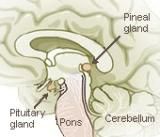
Function: The pineal gland is involved in several functions of the body including: * Secretion of the Hormone Melatonin* Regulation of Endocrine Functions * Conversion of Nervous System Signals to Endocrine Signals * Causes Feeling of Sleepiness * Influences Sexual Development Location: Directionally, the pineal gland is situated between the cerebral hemispheres, attached to the third ventricle.
-The pineal gland is a pine cone shaped gland of the endocrine system. A structure of the diencephalon of the brain, the pineal gland produces several important hormones including melatonin. |
|
|
ANS/ Neurilemma |
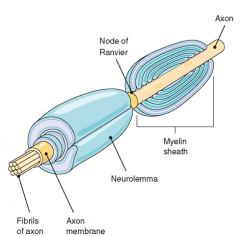
ANS (Automatic Nervous System)
Neurilemma: the thin membrane spirally enwrapping the myelin layers of certain fibers, especially of the peripheral nerves, or the axons of some unmyelinated nerve fibers. |
|
|
Olfactory lobe/ temporal |

Olfactory Lobe: A projection of the lower anterior portion of each cerebral hemisphere, functioning in the sense of smell.
Temporal Lobe: Location: Bottom middle part of cortex, right behind the temples The Temporal Lobe mainly revolves around hearing and selective listening. It receives sensory information such as sounds and speech from the ears. It is also key to being able to comprehend, or understand meaningful speech. |
|
|
Chemoreception |
The physiological response of a sense organ to a chemical stimulus.
A chemoreceptor, also known as chemosensor, is a sensory receptor that transduces a chemical signal into an action potential. In more general terms, a chemosensor detects certain chemical stimuli in the environment. |
|
|
Terminal end bulbs |
located at the end of the neuron and are responsible for sending the signal on to other neurons. At the end of the terminal button is a gap known as a synapse. |
|
|
Lumbar puncture |
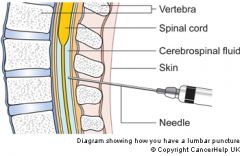
A lumbar puncture (LP) removes a small amount of cerebrospinal fluid (CSF) from the space around the spine for examination under a microscope. CSF is the fluid that surrounds the brain and spinal cord. A lumbar puncture is also called spinal tap and cerebrospinal fluid (CSF) collection. |
|
|
Photoreception |
any of the biological responses of animals to stimulation by light. In animals photoreception refers to mechanisms of light detection that lead to vision and depends on specialized light-sensitive cells called photoreceptors, which are located in the eye.
(response to stimulus of light) |
|
|
Meningitis/Stimulus |
Meningitis is an inflammation of the membranes (meninges) surrounding your brain and spinal cord. The swelling associated with meningitis often triggers the "hallmark" signs and symptoms of this condition, including headache, fever and a stiff neck. |
|
|
Dendrite/Myelin |
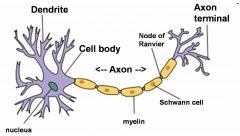
Dendrites are branched filaments in nerve cells (neurons). act to propagate the electrochemical stimulation received from other neural cells to the cell body, or soma, of the neuron from which the dendrites project.
Myelin is a fatty material that coats, protects, and insulates nerves, enabling them to quickly conduct impulses between the brain and different parts of the body. |
|
|
Epinephrine |
more commonly known as adrenaline, is a hormone (neurotransmitter) secreted by the medulla of the adrenal glands. Strong emotions such as fear or anger cause epinephrine to be released into the bloodstream, which causes an increase in heart rate, muscle strength, blood pressure, and sugar metabolism. |
|
|
Summation |
* Summation → series of subthreshold stimuli cumulate to cause an action potential
|
|
|
Occipital lobe |
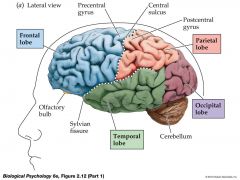
Location: Bottom, back part of the cortex
The occiptial lobe is important to being able to correctly understand what your eyes are seeing. These lobes have to be very fast to process the rapid information that our eyes are sending. |
|
|
Parietal Lobe |
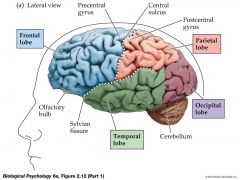
Location: Upper, back part of the cortex
The parietal lobe carries out some very specific functions. As a part of the cortex, it has a lot of responsibilities and has to be able to process sensory information within seconds. The parietal lobe is where information such as taste, temperature and touch are integrated, or processed. |
|
|
Thalamus
|
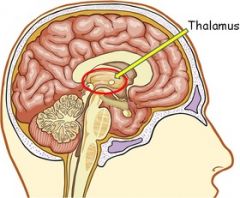
Location: Part of the forebrain, below the corpus callosum
Function: Responsible for relaying information from the sensory receptors to proper areas of the brain where it can be processed The thalamus is similar to a doctor that diagnoses, or identifies, a patient's disease or sickness. It diagnoses different sensory information that is being transmitted to the brain including auditory (relating to hearing or sound), visual, tactile (relating to touch), and gustatory (relating to taste) signals. After that, it directs the sensory information to the different parts and lobes of the cortex. |
|
|
Ganglion |
- a small cystic tumor (as on the back of the wrist) containing viscid fluid and connected either with a joint membrane or tendon sheath
- a mass of nerve tissue containing cell bodies of neurons that is located outside the central nervous system and forms an enlargement upon a nerve or upon two or more nerves at their point of junction or separation
- a mass of gray matter within the brain or spinal cord |
|
|
Dura Matter |
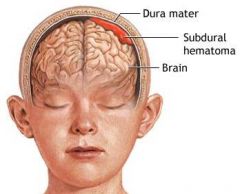
is a thick membrane that is the outermost of the three layers of the meninges that surround the brain and spinal cord. |
|
|
Proprioception/ Mechanoreception
|
Proprioception:
A sensory perception of motion and relative position of the body through the receptors in tissues such as muscles, tendons, inner ear and joints. example: leg hanging off bed; cannot see but you know its hanging off the bed Mechanoreception: a receptor that is excited by mechanical pressures or distortions, as those responding to touch and muscular contractions. |
|
|
Medulla Oblongata |
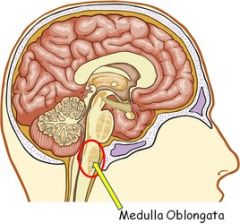
Location: Lower part of the brain stem The medulla is easily the most important part of the brain. It's functions are involuntary, or done without thought. We would not be able to live without the medulla because of the myriad of crucial tasks it performs including regulating blood pressure and breathing. As a part of the brain stem, it also helps transfer neural messages from the brain to the spinal cord. |
|
|
Circadium Rhythms |
Often referred to as the "body clock", the circadian rhythm is a 24-hour cycle that tells our bodies when to sleep and regulates many other physiological processes. This internal body clock is affected by environmental cues, like sunlight and temperature. |
|
|
Frontal Lobe |
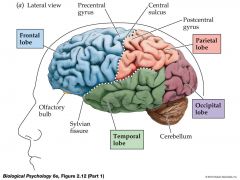
Location: Frontal and upper area of the cortex You use your frontal lobe nearly everyday. You use it to make decisions, such as what to eat or drink for breakfast in the morning, as well as for thinking or studying for a test. The frontal lobe is also where our personality is formed and where we can carry out higher mental processes such as planning. |
|
|
Stimulus |
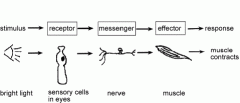
A stimulus is anything capable of evoking a response in an organism. Examples of stimuli include irritants, sights, sounds, heat, cold, smells, or other sensations. |

